
The LONDON TRANSPORT Leyland Titan TDsThis page created 18th July 2001 using Notepad, by Ian Smith. Best on Netscape 800*600.
Part One: the Red TitansThe London Titans - the 1930s variety - were not ordered by The London General Omnibus Company, nor London Transport. They were the basic bus for the many Independent bus companies that competed on some routes in the de-regulated period up until the London Transport Act ensured their eclipse within the LPTB fold in 1933. Each company had its own ideas about style and capacity of course. It was not like the later days when the Leyland National was available in green or red, long or short, only. Leyland produced the popular TD1 Leyland Titan chassis - mostly petrol engined, and the more powerful TD2, but bodies were the choice of the operator.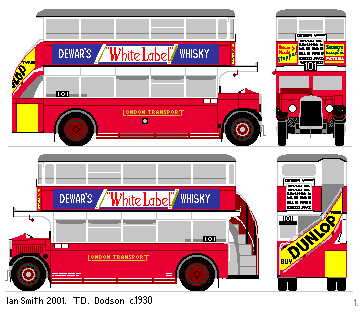 There were some constraints, not least from the London Public Carriage Office.
Metropolitan London would not permit low-height buses.
This eliminated the Leyland - style body popular elsewhere in the country,
with its thirteen feet high body, sunken offside gangway and bench seats.
The powers that were said that this delayed loading and unloading too much,
and would cause too much congestion. (Some concerns never change, it seems).
There were some constraints, not least from the London Public Carriage Office.
Metropolitan London would not permit low-height buses.
This eliminated the Leyland - style body popular elsewhere in the country,
with its thirteen feet high body, sunken offside gangway and bench seats.
The powers that were said that this delayed loading and unloading too much,
and would cause too much congestion. (Some concerns never change, it seems).
1929 Dodson-bodied TDs had open staircases, open cabs, route boards and stencils.So the red London Titans were over fourteen feet high, with central gang-ways. They were twenty-six feet long (the maximum on four axles), seven feet six inches wide, and all except the last few originally had open staircases and no driver's windscreens - courtesy of the LPCO.Apart from that there was variety. Dodson, Birch and Duple were the three main body suppliers, each with their own styles. It is amazing, though, how much bodywork design changed in the three years from 1929 to 1932 as the constraints were lifted: the early buses looked like 1920's relics; the later ones looked like modern buses. 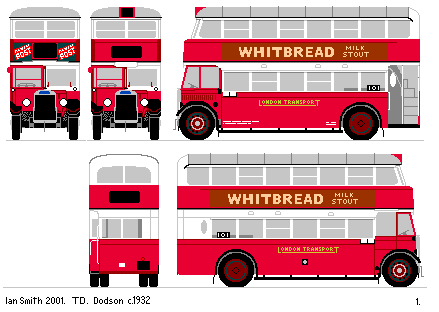 Dodson was a London body-builder that catered only for the Independents.
His early Titans were flimsy-looking five-bay buses with open staircases and open cabs.
The route boards required the triple front windows upstairs,
so that the boards could be changed.
There were stencil holders on the sides, above the windows, for route numbers.
Some had hopper-opening clerestories above the middle three side-windows (like the NS),
while others sported full drop windows in the first three bays
(where the wheel-arch didn't get it the way).
Dodson was a London body-builder that catered only for the Independents.
His early Titans were flimsy-looking five-bay buses with open staircases and open cabs.
The route boards required the triple front windows upstairs,
so that the boards could be changed.
There were stencil holders on the sides, above the windows, for route numbers.
Some had hopper-opening clerestories above the middle three side-windows (like the NS),
while others sported full drop windows in the first three bays
(where the wheel-arch didn't get it the way).
In 1931 Dodson revealed a totally new model. These TDs were a modern design: they had enclosed staircases, proper cabs, six-bay construction projected over the cab, route blinds and half-drop windows. Some had roofboxes on the front, some had a destination aperture in the band above the cab. There were several sizes and shapes of front blind apertures. Late Dodsons: the rear view in this drawing is more than usually conjectural, as I have not yet located a rear view.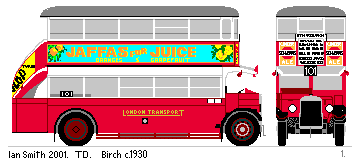 Birch mainly made bodies for Birch Brothers,
but also produced some for other Independents.
Their early bodies were also from the 1920s pattern-book,
being very similar to contemporary Dodson bodies.
Distinguishing features included the drooping canopy over the driver,
and shallower lower-deck windows.
Birch mainly made bodies for Birch Brothers,
but also produced some for other Independents.
Their early bodies were also from the 1920s pattern-book,
being very similar to contemporary Dodson bodies.
Distinguishing features included the drooping canopy over the driver,
and shallower lower-deck windows.
1929 Birch-bodied TD with open staircase, open cab, route board and stencils.But by 1932 Birch were producing some very modern-looking buses, with raked back fronts, enclosed cabs, enclosed staircases, blinds, ventilators and rooftop number stencils.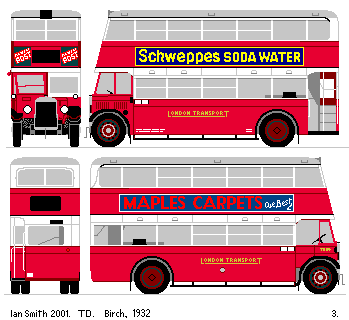
1932 Birch-bodied TD2: a modern bus.By way of contrast, in 1932 City was still buying open-back Dodson doubledeckers with very high skirts (with quadruple guard-rails), perversely mounted on TS3 Tiger chassis, that in this case were referred to as Titan TD(Specials). They became TD110-121 on takeover in November 1934.Duple produced a dozen old-fashioned type bodies for Premier in 1930: TD60-71.
There were also a pair of single-decker buses.
TD86 was a 1930 Dodson doubledecker for Hawkins,
but was transferred in May 1932 to Reliance.
By the time that LPTB took over it had been rebodied as a single decker.
Takeover by London TransportThe London Transport Act established London Transport in July 1933, and the new Board set about taking over the Independents within its monopoly area. The first takeovers were in November 1933, followed by more in the next two months. The Board asked the independents to keep running on the Board's behalf until January 1934, when it took over operation and redistributed the buses.Other Independents were taken over during 1934, the last in December. Some independents, like Birch Bros, came most reluctantly. At first the Titans received fleetnumbers prefaced by L, but TD was soon settled upon as the class designator.
ex-Prince TD131B (Duple, 1931). Rear view conjectural.Withdrawal- and wartime dutiesUpton Park's motley collection mostly survived until the end of 1937, but at the end of December withdrawal started in earnest as roofbox STLs arrived to replace them, and by the beginning of February 1938 most were in store. A few were relicensed as traffic requirements varied, around thirty-five being the norm through 1938 and early 1939. The store of TDs, which were reasonable buses, if bodily out of fashion, was used to supply the fluctuating needs of the fleet, including Special Events, such as Wimbledon.Hanwell's diesel TDs were replaced by new STL16s in September 1939, and also went into store. The war meant that London Transport was not allowed to dispose of its redundant buses, and the TDs remained in store until 1940, when permission was granted for them to be redistributed nationally via Millburn Motors of Preston. Some of the nicer buses went to independents in Wales and Stroud, but most went to Liverpool Corporation Transport for use on works services to the ammunition factories that had sprung up on the outskirts of the city. At least one (TD 193) survived to become a (rebodied) mobile canteen after the war. The psychological solidarity exercise after the Blitz, when London received buses from around the UK for few months, led to a number of provincial Titans appearing, including some that had originated with London Independents that had previously had a spell with LT.
|
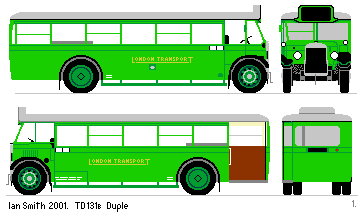 LPTB policy was to close down the small garages of the independents,
and group its new plethora of bus types together by type.
So all the petrol Titans were allocated to Upton Park (U),
and the oil-engined buses to Hanwell (HW).
Upton Park put them to work on the 86, 126 (East Ham- Victoria),
186 and 623 (1932 route numbers),
and then on the incredibly frequent 101 through the Docks between Wanstead and North Woolwich.
Hanwell put its diesels to work with its other diesel types on route 18.
The two single-decker buses, TD86 and TD131,
were transferred to the Country Area, working initially at Norhfleet NF, and later Slough (SL).
LPTB policy was to close down the small garages of the independents,
and group its new plethora of bus types together by type.
So all the petrol Titans were allocated to Upton Park (U),
and the oil-engined buses to Hanwell (HW).
Upton Park put them to work on the 86, 126 (East Ham- Victoria),
186 and 623 (1932 route numbers),
and then on the incredibly frequent 101 through the Docks between Wanstead and North Woolwich.
Hanwell put its diesels to work with its other diesel types on route 18.
The two single-decker buses, TD86 and TD131,
were transferred to the Country Area, working initially at Norhfleet NF, and later Slough (SL).
 Red TDs.
Red TDs. Part Two: Green TDs.
Part Two: Green TDs. Ian's Bus Stop
Ian's Bus Stop TR Tigers.
TR Tigers.